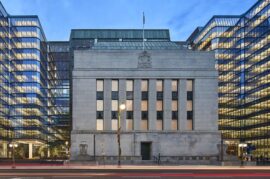An Update From The Bank of Canada

The Bank of Canada has started the new year announcing that it has left its target overnight benchmark rate unchanged at 0.25%. As a result, the Bank Rate stays at 0.5% and the knock-on effect is that borrowing costs for Canadians will remain low for the foreseeable future.
Prior to the announcement, there was some speculation that the Bank would make a “micro-cut” to its overnight rate, to no avail.
In its first quarterly Monetary Policy Report (MPR) of the year, the Bank also updated its observations on the state of the economy, both in Canada and globally and pledged to continue to support market liquidity through its quantitative easing program.

These are the highlights of the BoC announcement for the Canadian economy:
- Canada’s economy had strong momentum through late 2020, but the resurgence of COVID-19 cases and the reintroduction of lockdown measures present “a serious setback”
- Growth in the Canadian economy in Q1 2021 is now expected to be negative – even after a decline in real GDP of 5 ½% in 2020
- Unemployment remains elevated, particularly for workers in high-contact service industries who will once again be the hardest hit by lockdown measures
- Assuming pandemic restrictions are lifted later in the first quarter, the Bank expects a strong second-quarter 2021 rebound
- The Bank projects the Canadian economy will grow by 4% in 2021 and almost 5% in 2022 – a modest upward revision from the projections contained in its October 2020 Monetary Policy Report
- Beyond the near term, the outlook for Canada is “now stronger and more secure” than in the October projection, thanks to earlier-than-expected availability of vaccines and significant ongoing monetary and fiscal stimulus
Those were the claims on future inflation:
- Consumption is forecast to gain strength as parts of the economy reopen and confidence improves, and exports and business investment will be buoyed by rising foreign demand
- CPI inflation has risen to the low end of the Bank’s 1-3% target range in recent months, while measures of core inflation are still below 2%
- CPI inflation is forecast to rise temporarily to around 2% the first half of 2021, “as the base-year effects of price declines at the pandemic’s outset — mostly gasoline — dissipate”
- Excess supply is expected to weigh on inflation throughout the projection period and as it is absorbed, inflation is expected to return sustainably to the 2% target in 2023

The BoC also offered the following thoughts on the global economy:
- Global growth is expected to average just over 5% per year in 2021 and 2022 – before slowing to just over 4% in 2023
Looking to a more positive future
In the forward to its latest MPR, the Bank noted that is economic projections depend on important assumptions about how the pandemic will evolve. Of note, it assumed that the vaccine rollout will proceed largely as announced by governments and that Canada, other advanced economies and China will achieve “broad immunity by the end of 2021.”
In view of the weakness of near-term growth and the protracted nature of the recovery, the Bank indicated that the Canadian economy will continue to require “extraordinary monetary policy support.” Accordingly, the Bank’s Governing Council will hold the policy interest rate at the effective lower bound until economic slack is absorbed so that the 2% inflation target is sustainably achieved. Once again, the Bank indicated that is projections show that its inflation target will not be met until “in” 2023.
To keep interest rates low across the yield curve, the Bank promised to continue its quantitative easing program until the recovery is well underway. As the Governing Council gains confidence in the strength of the recovery, the pace of net purchases of Government of Canada bonds will be adjusted “as required.”
Parsing these comments, it would appear highly likely that interest rates will remain low for long.
Stay tuned for BoC’s next scheduled policy announcement on March 10, 2021.






